2004 DAEWOO LACETTI torque
[x] Cancel search: torquePage 119 of 2643
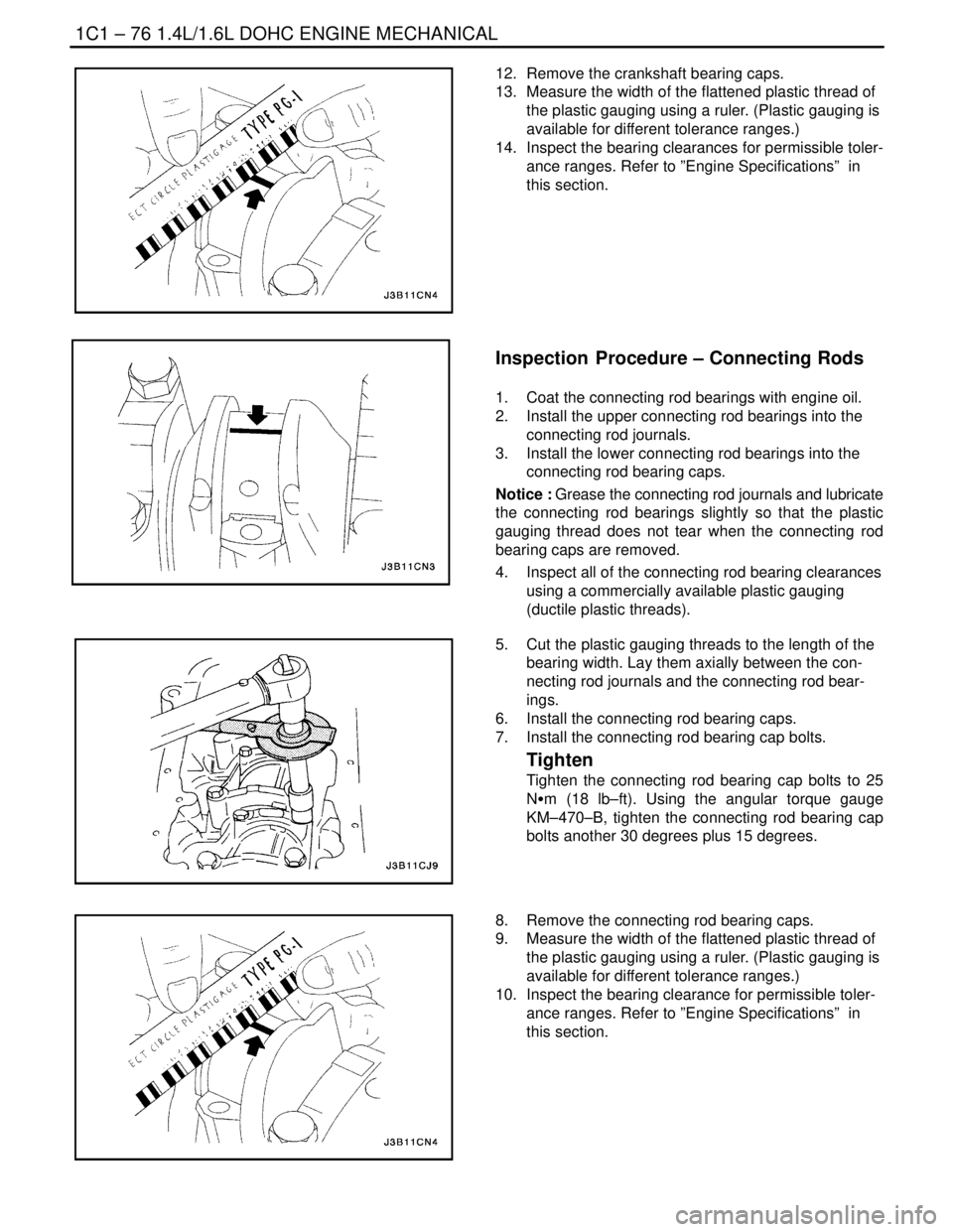
1C1 – 76I1.4L/1.6L DOHC ENGINE MECHANICAL
DAEWOO V–121 BL4
12. Remove the crankshaft bearing caps.
13. Measure the width of the flattened plastic thread of
the plastic gauging using a ruler. (Plastic gauging is
available for different tolerance ranges.)
14. Inspect the bearing clearances for permissible toler-
ance ranges. Refer to ”Engine Specifications” in
this section.
Inspection Procedure – Connecting Rods
1. Coat the connecting rod bearings with engine oil.
2. Install the upper connecting rod bearings into the
connecting rod journals.
3. Install the lower connecting rod bearings into the
connecting rod bearing caps.
Notice : Grease the connecting rod journals and lubricate
the connecting rod bearings slightly so that the plastic
gauging thread does not tear when the connecting rod
bearing caps are removed.
4. Inspect all of the connecting rod bearing clearances
using a commercially available plastic gauging
(ductile plastic threads).
5. Cut the plastic gauging threads to the length of the
bearing width. Lay them axially between the con-
necting rod journals and the connecting rod bear-
ings.
6. Install the connecting rod bearing caps.
7. Install the connecting rod bearing cap bolts.
Tighten
Tighten the connecting rod bearing cap bolts to 25
NSm (18 lb–ft). Using the angular torque gauge
KM–470–B, tighten the connecting rod bearing cap
bolts another 30 degrees plus 15 degrees.
8. Remove the connecting rod bearing caps.
9. Measure the width of the flattened plastic thread of
the plastic gauging using a ruler. (Plastic gauging is
available for different tolerance ranges.)
10. Inspect the bearing clearance for permissible toler-
ance ranges. Refer to ”Engine Specifications” in
this section.
Page 120 of 2643

1.4L/1.6L DOHC ENGINE MECHANICAL 1C1 – 77
DAEWOO V–121 BL4
GENERAL DESCRIPTION
AND SYSTEM OPERATION
CYLINDER HEAD AND GASKET
The cylinder head is made of an aluminum alloy. The cylin-
der head uses cross–flow intake and exhaust ports. A
spark plug is located in the center of each combustion
chamber. The cylinder head houses the dual camshafts.
CRANKSHAFT
The crankshaft has eight integral weights which are cast
with it for balancing. Oil holes run through the center of the
crankshaft to supply oil to the connecting rods, the bear-
ings, the pistons, and the other components. The end
thrust load is taken by the thrust washers installed at the
center journal.
TIMING BELT
The timing belt coordinates the crankshaft and the dual
overhead camshafts and keeps them synchronized. The
timing belt also turns the water pump. The timing belt and
the pulleys are toothed so that there is no slippage be-
tween them. There are two idler pulleys. An automatic ten-
sioner pulley maintains the timing belt’s correct tension.
The timing belt is made of a tough reinforced rubber similar
to that used on the serpentine accessory drive belt. The
timing belt requires no lubrication.
OIL PUMP
The oil pump draws engine oil from the oil pan and feeds
it under pressure to the various parts of the engine. An oil
strainer is mounted before the inlet of the oil pump to re-
move impurities which could clog or damage the oil pump
or other engine components. When the drive gear rotates,
the driven gear rotates. This causes the space between
the gears to constantly open and narrow, pulling oil in from
the oil pan when the space opens and pumping the oil out
to the engine as it narrows.
At high engine speeds, the oil pump supplies a much high-
er amount of oil than is required for lubrication of the en-
gine. The oil pressure regulator prevents too much oil from
entering the engine lubrication passages. During normal
oil supply, a coil spring and valve keep the bypass closed,
directing all of the oil pumped to the engine. When the
amount of oil being pumped increases, the pressure be-
comes high enough to overcome the force of the spring.This opens the valve of the oil pressure regulator, allowing
the excess oil to flow through the valve and drain back to
the oil pan.
OIL PAN
The engine oil pan is mounted to the bottom of the cylinder
block. The engine oil pan houses the crankcase and is
made of cast metal.
Engine oil is pumped from the oil pan by the oil pump. After
it passes through the oil filter, it is fed through two paths
to lubricate the cylinder block and the cylinder head. In one
path, the oil is pumped through the oil passages in the
crankshaft to the connecting rods, then to the pistons and
the cylinders. It then drains back to the oil pan. In the sec-
ond path, the oil is pumped through the oil passages to the
camshaft. The oil passes through the internal passage-
ways in the camshafts to lubricate the valve assemblies
before draining back to the oil pan.
EXHAUST MANIFOLD
A single four–port, rear–takedown manifold is used with
this engine. The manifold is designed to direct escaping
exhaust gases out of the combustion chambers with a
minimum of back pressure. The oxygen sensor is
mounted to the exhaust manifold.
INTAKE MANIFOLD
The intake manifold has four independent long ports and
uses inertial supercharging to improve engine torque at
low and moderate speeds. The plenum is attached to the
intake manifold.
CAMSHAFTS
This engine is a dual overhead camshaft (DOHC) type,
which means there are two camshafts. One camshaft op-
erates the intake valves, and the other camshaft operates
the exhaust valves. The camshafts sit in journals on the
top of the engine in the cylinder head and are held in place
by camshaft caps. The camshaft journals of the cylinder
head are drilled to create oil passages. Engine oil travels
to the camshafts under pressure where it lubricates each
camshaft journal. The oil returns to the oil pan through
drain holes in the cylinder head. The camshaft lobes are
machined into the solid camshaft to open and close the in-
take and the exhaust valves precisely the correct amount
at the correct time. The camshaft lobes are oiled by splash
action from pressurized oil escaping from the camshaft
journals.
Page 125 of 2643
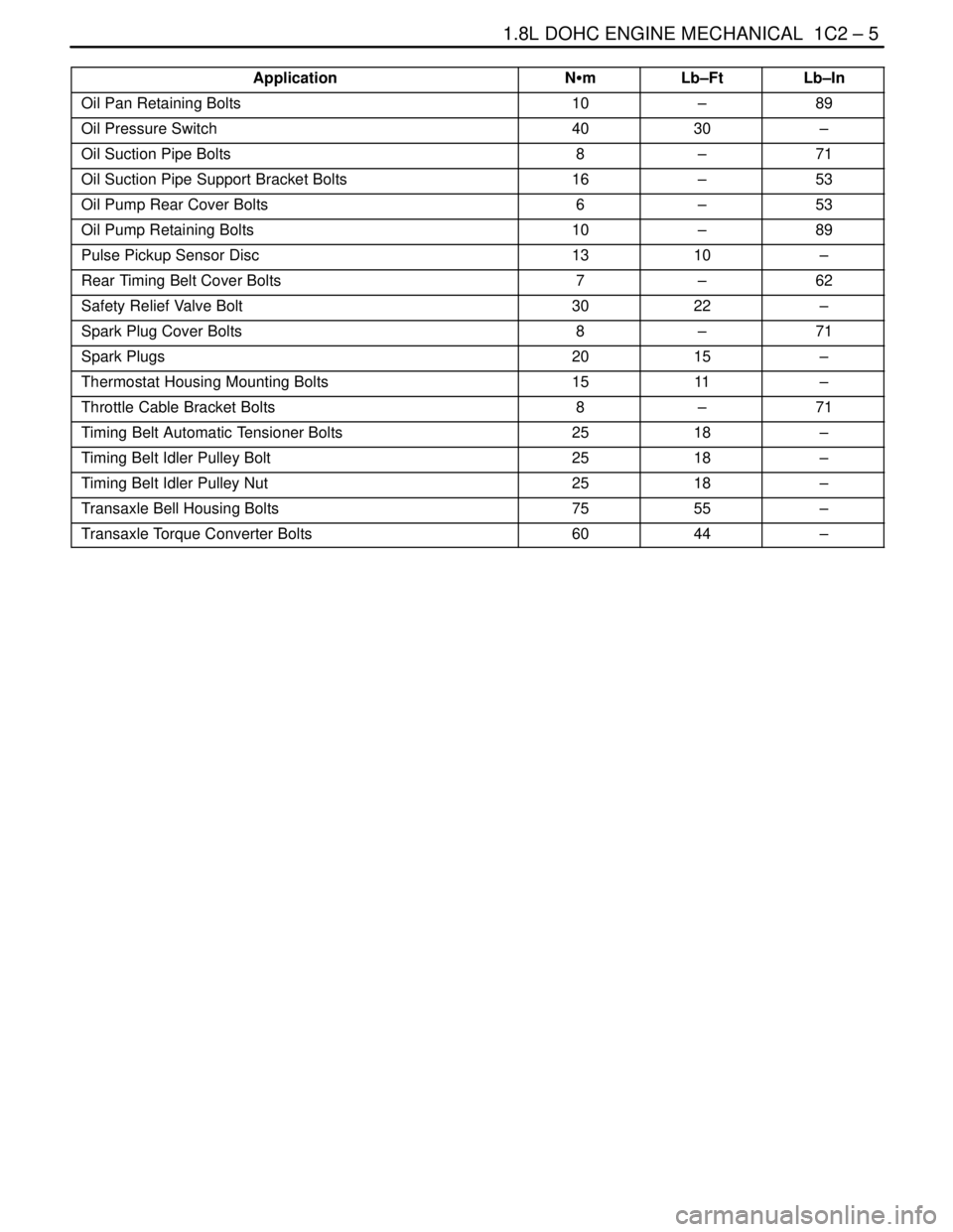
1.8L DOHC ENGINE MECHANICAL 1C2 – 5
DAEWOO V–121 BL4
Application Lb–InLb–Ft NSm
Oil Pan Retaining Bolts10–89
Oil Pressure Switch4030–
Oil Suction Pipe Bolts8–71
Oil Suction Pipe Support Bracket Bolts16–53
Oil Pump Rear Cover Bolts6–53
Oil Pump Retaining Bolts10–89
Pulse Pickup Sensor Disc1310–
Rear Timing Belt Cover Bolts7–62
Safety Relief Valve Bolt3022–
Spark Plug Cover Bolts8–71
Spark Plugs2015–
Thermostat Housing Mounting Bolts1511–
Throttle Cable Bracket Bolts8–71
Timing Belt Automatic Tensioner Bolts2518–
Timing Belt Idler Pulley Bolt2518–
Timing Belt Idler Pulley Nut2518–
Transaxle Bell Housing Bolts7555–
Transaxle Torque Converter Bolts6044–
Page 127 of 2643
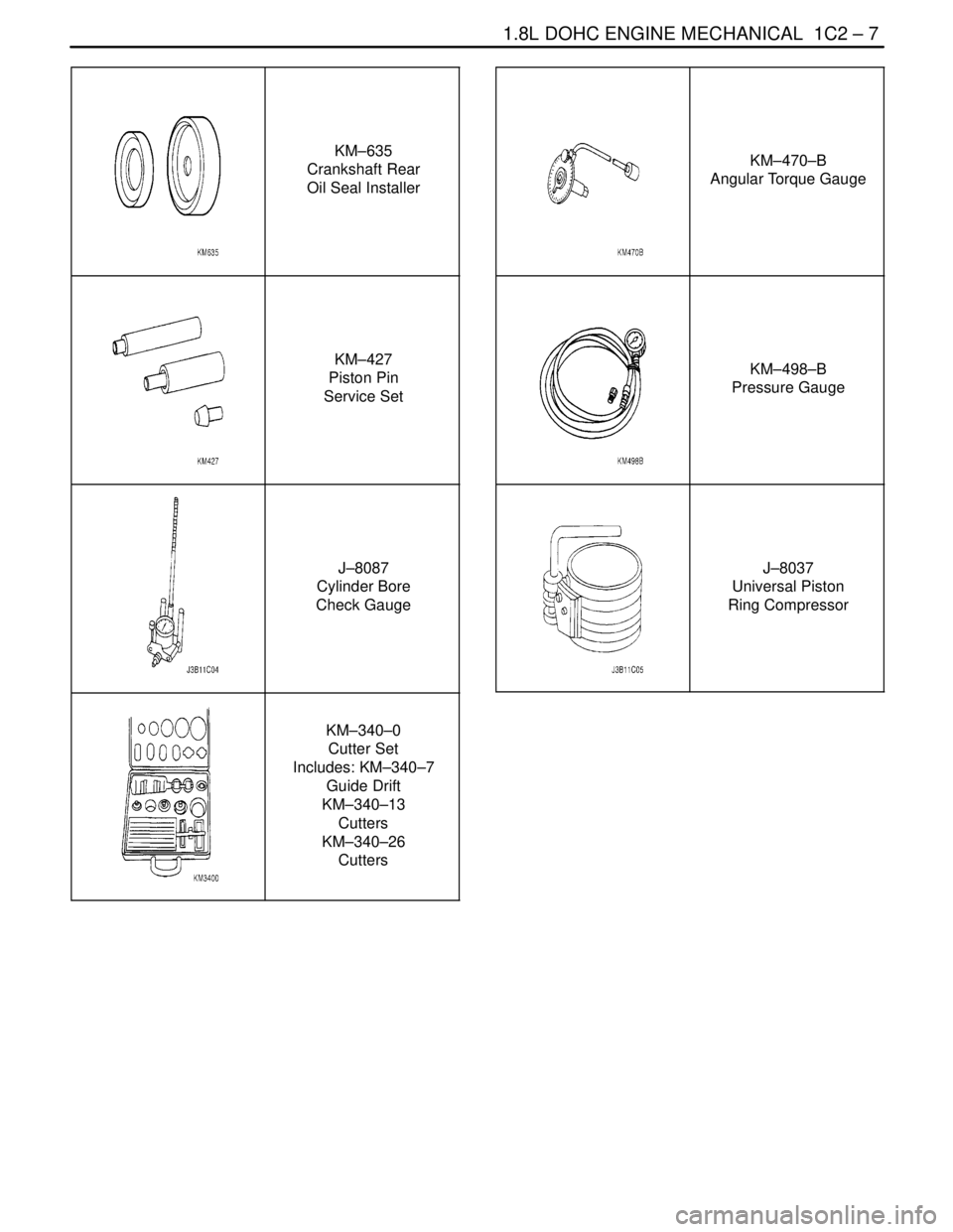
1.8L DOHC ENGINE MECHANICAL 1C2 – 7
DAEWOO V–121 BL4
KM–635
Crankshaft Rear
Oil Seal Installer
KM–427
Piston Pin
Service Set
J–8087
Cylinder Bore
Check Gauge
KM–340–0
Cutter Set
Includes: KM–340–7
Guide Drift
KM–340–13
Cutters
KM–340–26
Cutters
KM–470–B
Angular Torque Gauge
KM–498–B
Pressure Gauge
J–8037
Universal Piston
Ring Compressor
Page 133 of 2643
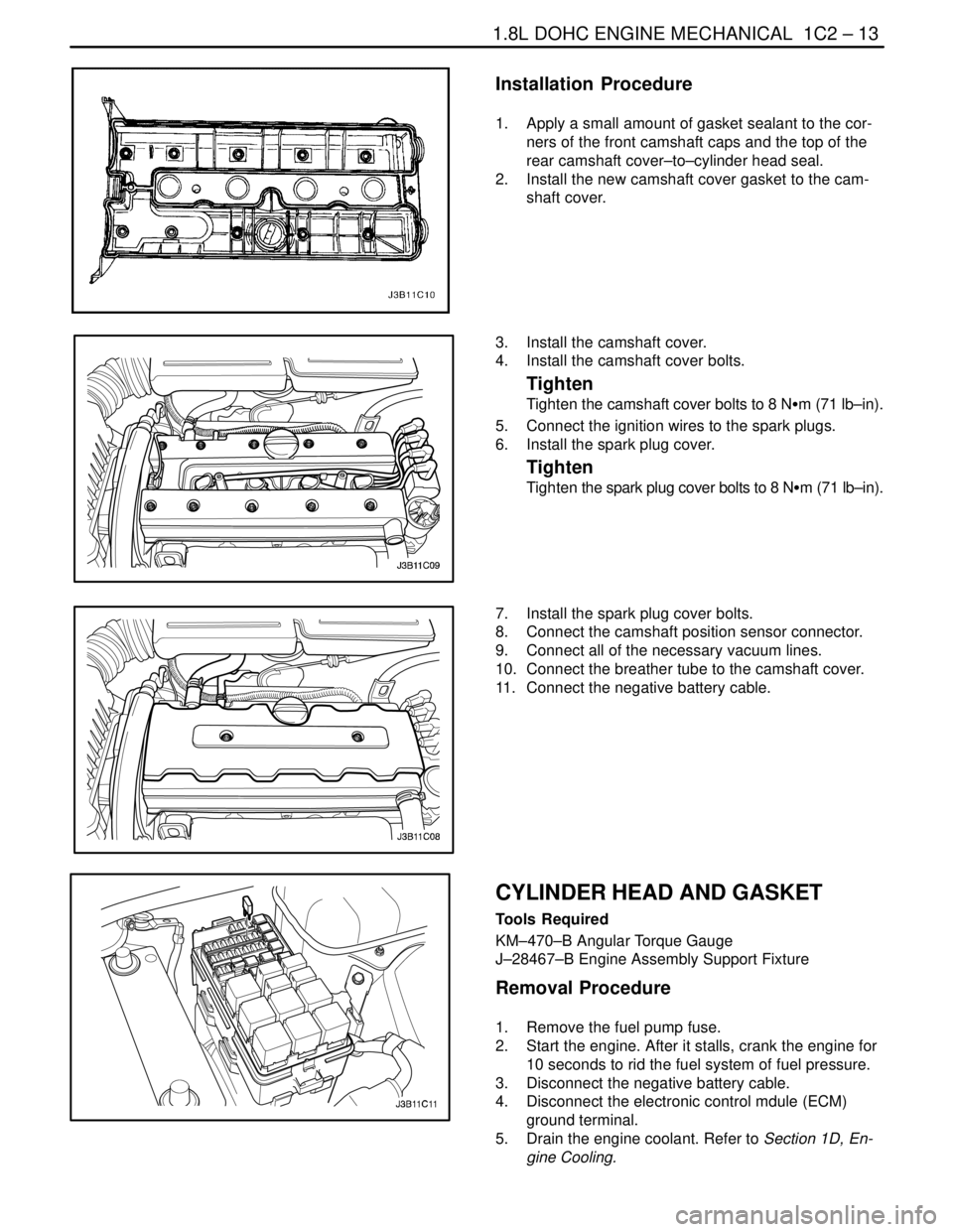
1.8L DOHC ENGINE MECHANICAL 1C2 – 13
DAEWOO V–121 BL4
Installation Procedure
1. Apply a small amount of gasket sealant to the cor-
ners of the front camshaft caps and the top of the
rear camshaft cover–to–cylinder head seal.
2. Install the new camshaft cover gasket to the cam-
shaft cover.
3. Install the camshaft cover.
4. Install the camshaft cover bolts.
Tighten
Tighten the camshaft cover bolts to 8 NSm (71 lb–in).
5. Connect the ignition wires to the spark plugs.
6. Install the spark plug cover.
Tighten
Tighten the spark plug cover bolts to 8 NSm (71 lb–in).
7. Install the spark plug cover bolts.
8. Connect the camshaft position sensor connector.
9. Connect all of the necessary vacuum lines.
10. Connect the breather tube to the camshaft cover.
11. Connect the negative battery cable.
CYLINDER HEAD AND GASKET
Tools Required
KM–470–B Angular Torque Gauge
J–28467–B Engine Assembly Support Fixture
Removal Procedure
1. Remove the fuel pump fuse.
2. Start the engine. After it stalls, crank the engine for
10 seconds to rid the fuel system of fuel pressure.
3. Disconnect the negative battery cable.
4. Disconnect the electronic control mdule (ECM)
ground terminal.
5. Drain the engine coolant. Refer to Section 1D, En-
gine Cooling.
Page 138 of 2643
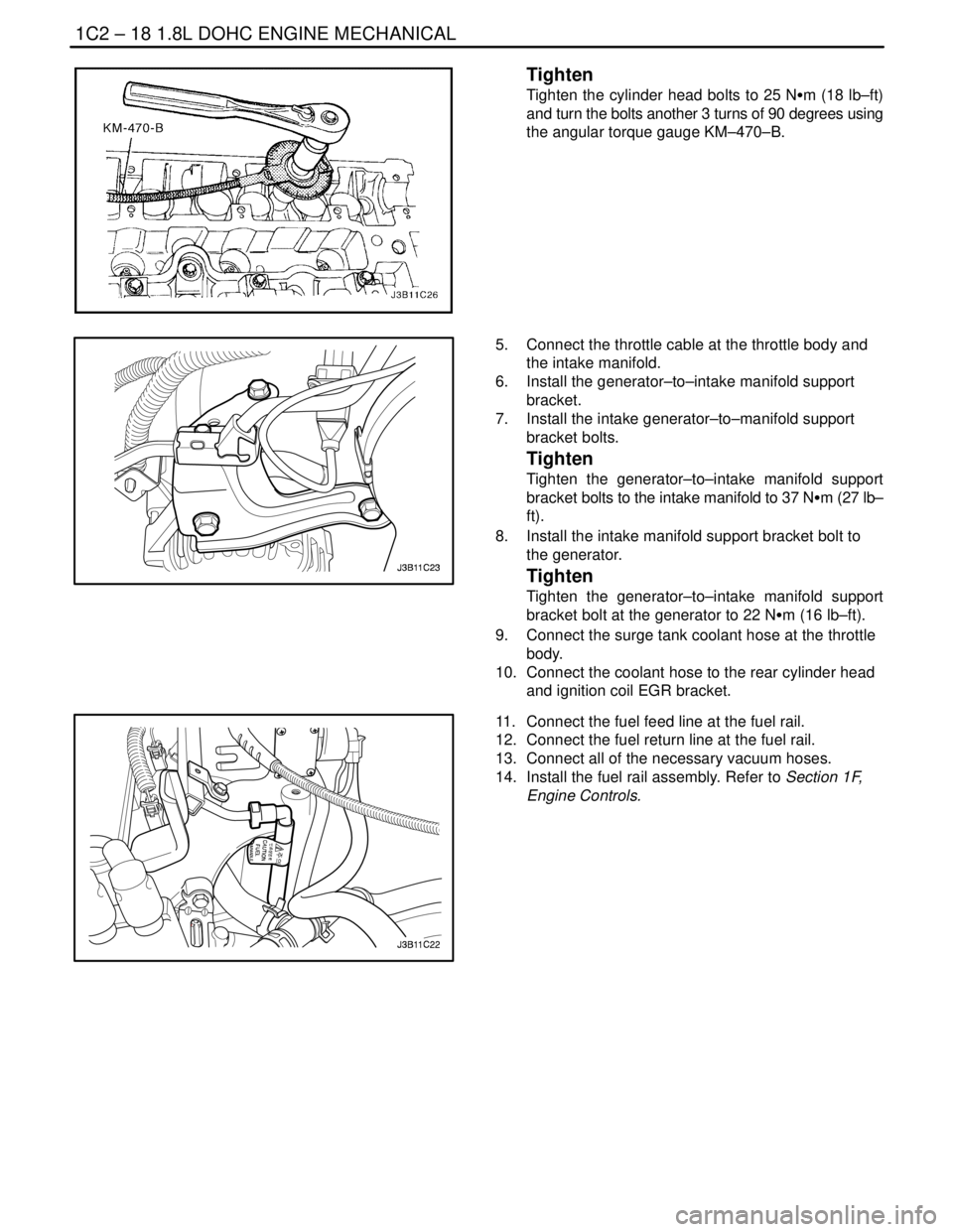
1C2 – 18I1.8L DOHC ENGINE MECHANICAL
DAEWOO V–121 BL4
Tighten
Tighten the cylinder head bolts to 25 NSm (18 lb–ft)
and turn the bolts another 3 turns of 90 degrees using
the angular torque gauge KM–470–B.
5. Connect the throttle cable at the throttle body and
the intake manifold.
6. Install the generator–to–intake manifold support
bracket.
7. Install the intake generator–to–manifold support
bracket bolts.
Tighten
Tighten the generator–to–intake manifold support
bracket bolts to the intake manifold to 37 NSm (27 lb–
ft).
8. Install the intake manifold support bracket bolt to
the generator.
Tighten
Tighten the generator–to–intake manifold support
bracket bolt at the generator to 22 NSm (16 lb–ft).
9. Connect the surge tank coolant hose at the throttle
body.
10. Connect the coolant hose to the rear cylinder head
and ignition coil EGR bracket.
11. Connect the fuel feed line at the fuel rail.
12. Connect the fuel return line at the fuel rail.
13. Connect all of the necessary vacuum hoses.
14. Install the fuel rail assembly. Refer to Section 1F,
Engine Controls.
Page 139 of 2643
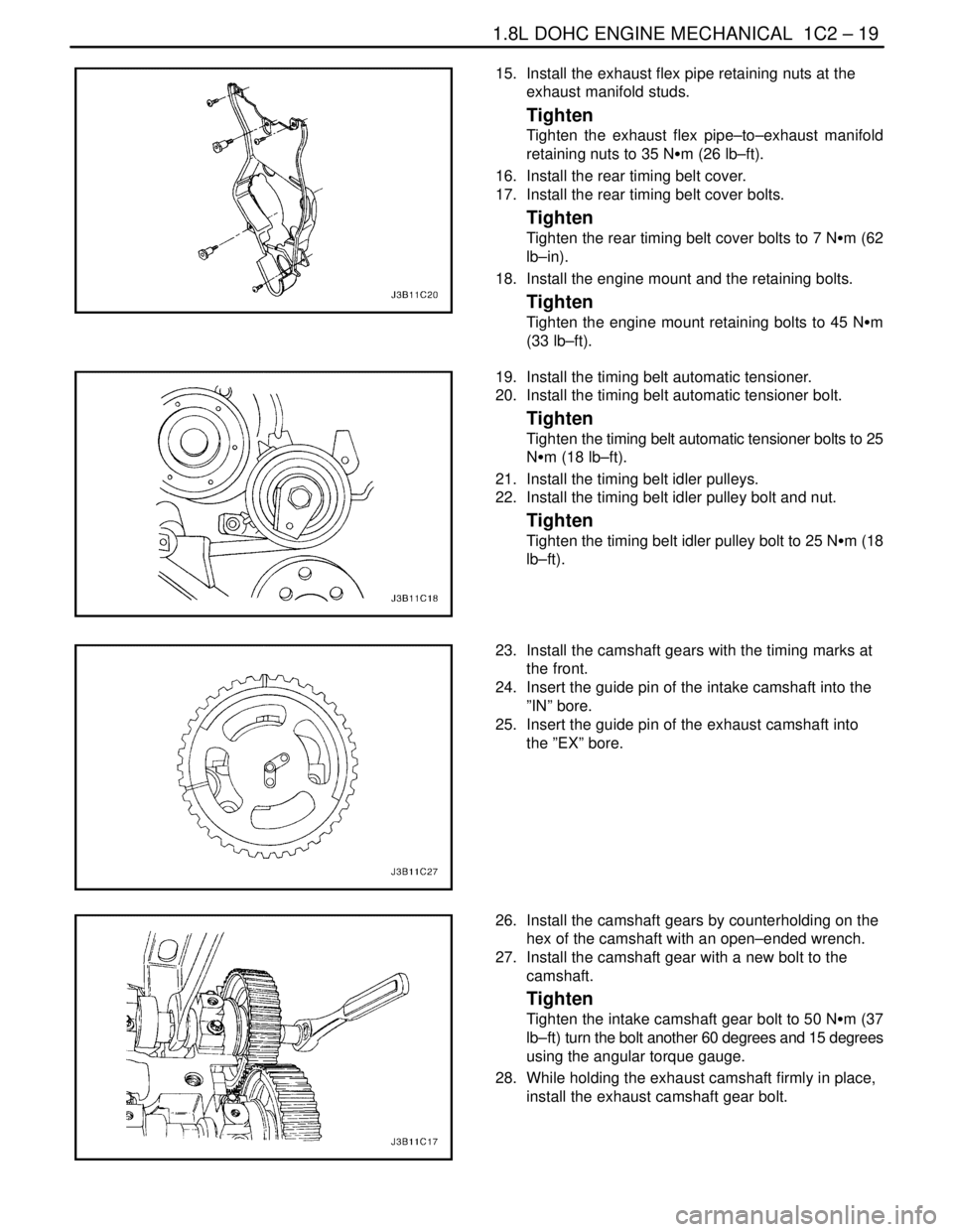
1.8L DOHC ENGINE MECHANICAL 1C2 – 19
DAEWOO V–121 BL4
15. Install the exhaust flex pipe retaining nuts at the
exhaust manifold studs.
Tighten
Tighten the exhaust flex pipe–to–exhaust manifold
retaining nuts to 35 NSm (26 lb–ft).
16. Install the rear timing belt cover.
17. Install the rear timing belt cover bolts.
Tighten
Tighten the rear timing belt cover bolts to 7 NSm (62
lb–in).
18. Install the engine mount and the retaining bolts.
Tighten
Tighten the engine mount retaining bolts to 45 NSm
(33 lb–ft).
19. Install the timing belt automatic tensioner.
20. Install the timing belt automatic tensioner bolt.
Tighten
Tighten the timing belt automatic tensioner bolts to 25
NSm (18 lb–ft).
21. Install the timing belt idler pulleys.
22. Install the timing belt idler pulley bolt and nut.
Tighten
Tighten the timing belt idler pulley bolt to 25 NSm (18
lb–ft).
23. Install the camshaft gears with the timing marks at
the front.
24. Insert the guide pin of the intake camshaft into the
”IN” bore.
25. Insert the guide pin of the exhaust camshaft into
the ”EX” bore.
26. Install the camshaft gears by counterholding on the
hex of the camshaft with an open–ended wrench.
27. Install the camshaft gear with a new bolt to the
camshaft.
Tighten
Tighten the intake camshaft gear bolt to 50 NSm (37
lb–ft) turn the bolt another 60 degrees and 15 degrees
using the angular torque gauge.
28. While holding the exhaust camshaft firmly in place,
install the exhaust camshaft gear bolt.
Page 140 of 2643
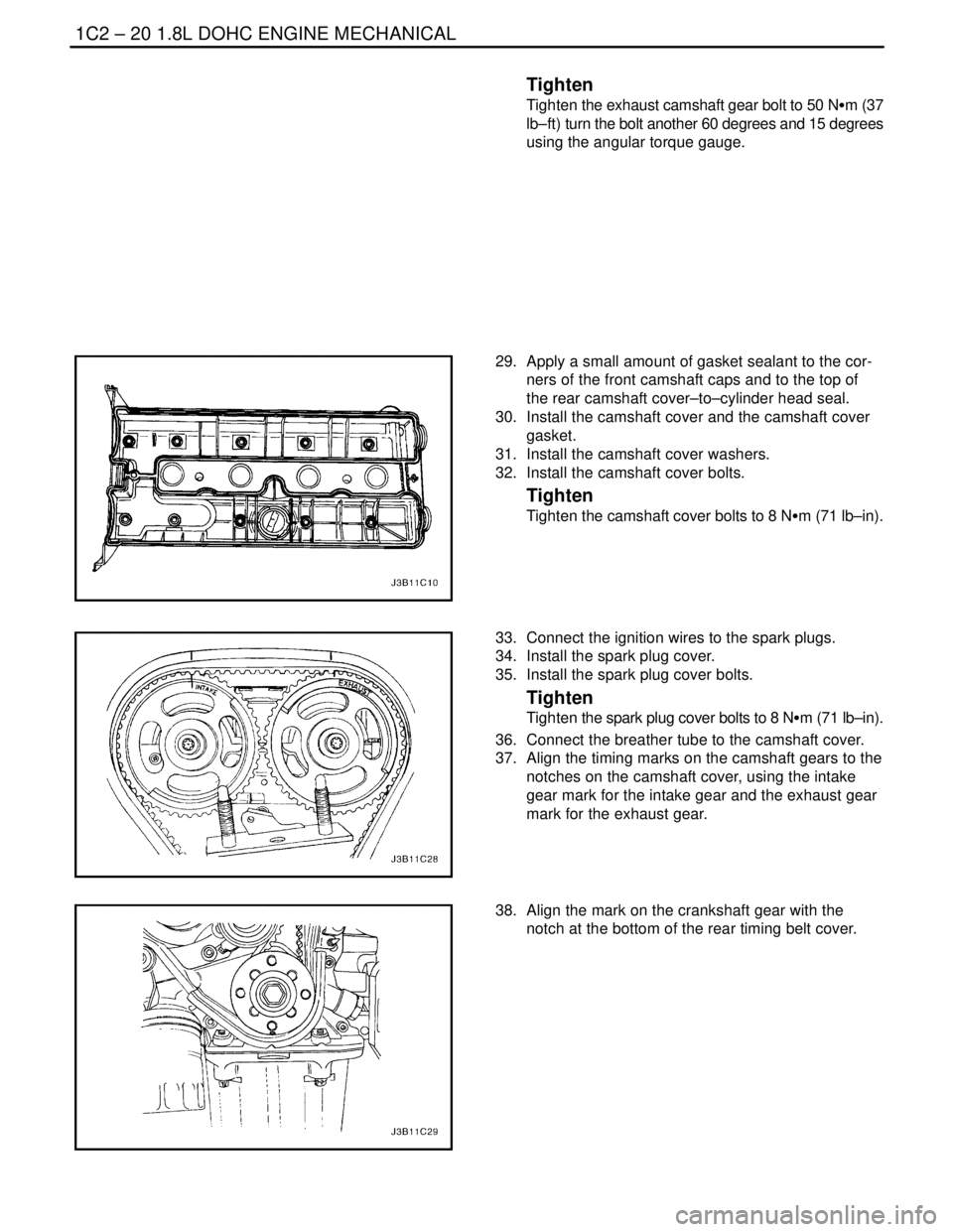
1C2 – 20I1.8L DOHC ENGINE MECHANICAL
DAEWOO V–121 BL4
Tighten
Tighten the exhaust camshaft gear bolt to 50 NSm (37
lb–ft) turn the bolt another 60 degrees and 15 degrees
using the angular torque gauge.
29. Apply a small amount of gasket sealant to the cor-
ners of the front camshaft caps and to the top of
the rear camshaft cover–to–cylinder head seal.
30. Install the camshaft cover and the camshaft cover
gasket.
31. Install the camshaft cover washers.
32. Install the camshaft cover bolts.
Tighten
Tighten the camshaft cover bolts to 8 NSm (71 lb–in).
33. Connect the ignition wires to the spark plugs.
34. Install the spark plug cover.
35. Install the spark plug cover bolts.
Tighten
Tighten the spark plug cover bolts to 8 NSm (71 lb–in).
36. Connect the breather tube to the camshaft cover.
37. Align the timing marks on the camshaft gears to the
notches on the camshaft cover, using the intake
gear mark for the intake gear and the exhaust gear
mark for the exhaust gear.
38. Align the mark on the crankshaft gear with the
notch at the bottom of the rear timing belt cover.